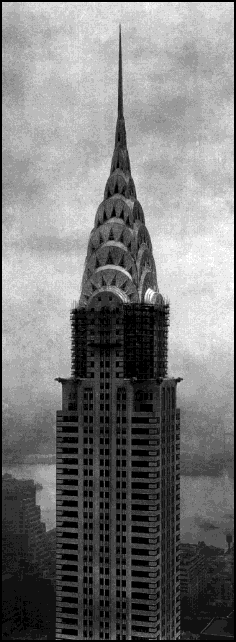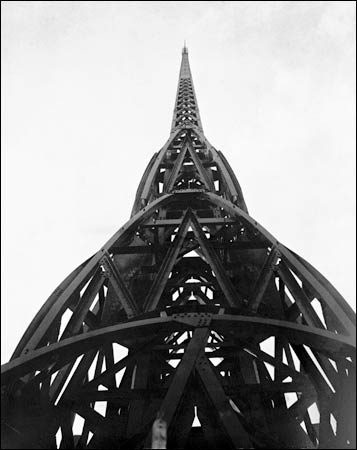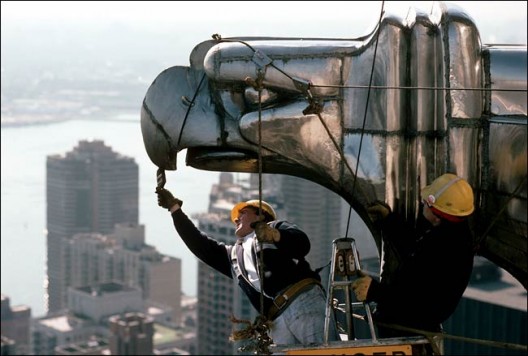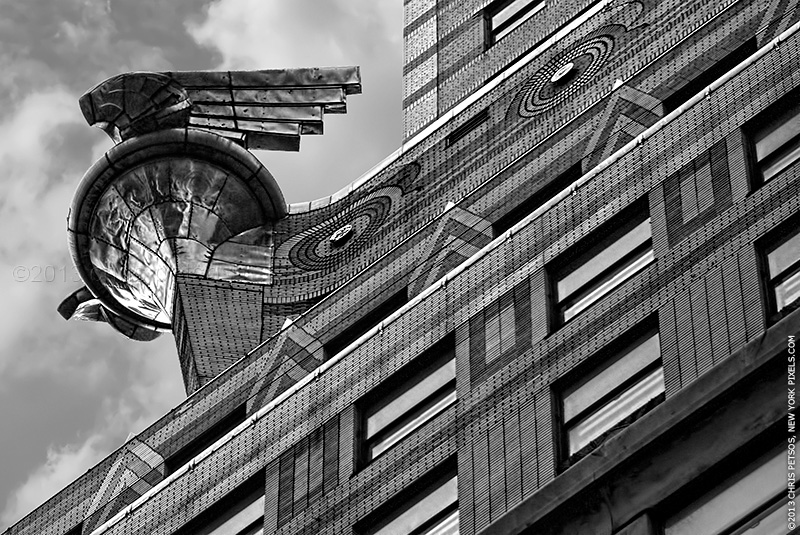Creating a New Icon
Day by Day
David Stravitz
(Princeton Architectural)

The railroad itself referred to the majestic old building as "a white elephant," and the New York Daily News praised the demolition as the price of progress. "The fact is that no busy location in Manhattan can indefinitely support a two-story building, however reminiscent of ancient Rome," the editors wrote, demonstrating their usual acute sense of aesthetics: "The new structure may not be a beauty, but at least it will be convenient."
 The message of New York's Pennsylvania Stations is that the people in that particular city must loathe their surroundings --- most especially the old and the glorious. And if you think things have changed for the better, just look at the new plans for the site of the WTC. The original edifices were nothing to write home about, and the proposed replacements are more of the same ilk: cold icy towers, pedestrian-destroying layout, maximum profit --- use the land to the hilt, to hell with humanity.
The message of New York's Pennsylvania Stations is that the people in that particular city must loathe their surroundings --- most especially the old and the glorious. And if you think things have changed for the better, just look at the new plans for the site of the WTC. The original edifices were nothing to write home about, and the proposed replacements are more of the same ilk: cold icy towers, pedestrian-destroying layout, maximum profit --- use the land to the hilt, to hell with humanity.One of the miracles is that somehow those who own the city have not yet decided to murder that funny monument to the Moderne, the Chrysler Building. It went into bankruptcy a quarter century ago, but the Trump and Zeckendorf and David Bevan types (Bevan was the corporate director responsible for ordering the trashing of Penn Station) must have been too busy with other massacres, obviously didn't have time to do it in.
David Stravitz is a photography nut, and when he was buying up some antique camera parts in an old camera shop in Manhattan, he asked the owner about the boxes in the corner, and the owner said that they were just some old photos that he was going to sell as salvage for their silver content. Stravitz looked at them, found them to be the working photographs of the construction of the Chrysler Building, from 1929 - 1930, and bought them on the spot.
It was the practice in those days for the engineers and architects to make photographs of the building-in- It's all here --- from hole in the ground to the final spire atop the seventy-seventh story, complete with vistas in four directions of the Manhattan that we had come to love so many years ago: the trolleys, the Third and Second Avenue elevateds, the old cars, the ladies in their funny hats and coats. And then too, the great steel-clad eagles hanging out over the sixty-first story level, along with the weird triangular windows of the Observatory, the stainless steel ("Enduro-KA-2 Steel") arching so neatly up to the peak which lay "1046 feet, 4-3/4 inches above Lexington Avenue." Finally, there was the "Cloud Club" (Cloud Club!) on floors 66 - 68 for all the business types of New York City. Princeton Architectural Press has elected to leave all comments until the end of the book: so you have well- Some of the shots of the tower clean and new and white and pure make one long, ah so, for that innocent time when the decorative arts could involve a whole unified structure, where straight lines were softened by curve and decoration so that a building was not mere brute bookend tossed down on a cityscape but rather a touch of divinity littered so gently by the gods to teach us the relative immortality of earthly structures and a holy interweaving of the divine arts into the soul of mankind. Got that? Then there are the men in their fedoras overlooking the construction site, the interior shots of polished black marble walls, the aluminum-leaf ceiling, the thirty elevator cabs with wood inlay --- along with Edward Trumball's ridiculous mural, in the 30's love-
Then there are the men in their fedoras overlooking the construction site, the interior shots of polished black marble walls, the aluminum-leaf ceiling, the thirty elevator cabs with wood inlay --- along with Edward Trumball's ridiculous mural, in the 30's love-
